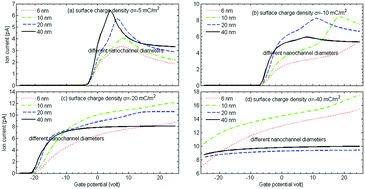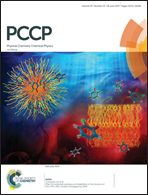Current–voltage characteristics influenced by the nanochannel diameter and surface charge density in a fluidic field-effect-transistor
Abstract
The nanochannel diameter and surface charge density have a significant impact on current–voltage characteristics in a nanofluidic transistor. We have simulated the effect of the channel diameter and surface charge density on current–voltage characteristics of a fluidic nanochannel with positive surface charge on its walls and a gate electrode on its surface. Anion depletion/enrichment leads to a decrease/increase in ion current with gate potential. The ion current tends to increase linearly with gate potential for narrow channels at high surface charge densities and narrow channels are more effective to control the ion current at high surface charge densities. The current–voltage characteristics are highly nonlinear for wide channels at low surface charge densities and they show different regions of current change with gate potential. The ion current decreases with gate potential after attaining a peak value for wide channels at low values of surface charge densities. At low surface charge densities, the ion current can be controlled by a narrow range of gate potentials for wide channels. The current change with source drain voltage shows ohmic, limiting and overlimiting regions.

- This article is part of the themed collection: 2017 PCCP HOT Articles


 Please wait while we load your content...
Please wait while we load your content...